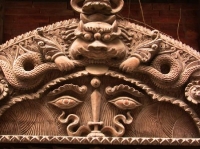Tridosha Siddhanta is the central concept of Ayurvedic medicine, the theory that health exists when there is a balance between three fundamental bodily substances called Vata, Pitta and Kapha. All Ayurvedic physicians firmly believe that these ancient ideas, based in the spiritual knowledge discovered by the Rishis and Munis, exist in harmony with physical realities. These are the Ayurvedic concepts that allow physicians to examine the status of whole system homeostasis.
 Direct associations between the philosophical/medical concepts and the physiological realities they represent are necessary to gain a practical clinical understanding of Ayurveda. These medical concepts can be complex to grasp, as they embrace the full spectrum of medicine and disease. They are both rooted in philosophy and in harmony with physical realities. To fully comprehend them they must be explained from several angles, and then applied within the context of the clinical practice of medicine. It is especially important to understand that when this textbook describes Vata, Pitta and Kapha from various angles, that the terms embrace all the angles, and cannot be limited to narrow or single areas of their meaning.
Direct associations between the philosophical/medical concepts and the physiological realities they represent are necessary to gain a practical clinical understanding of Ayurveda. These medical concepts can be complex to grasp, as they embrace the full spectrum of medicine and disease. They are both rooted in philosophy and in harmony with physical realities. To fully comprehend them they must be explained from several angles, and then applied within the context of the clinical practice of medicine. It is especially important to understand that when this textbook describes Vata, Pitta and Kapha from various angles, that the terms embrace all the angles, and cannot be limited to narrow or single areas of their meaning.
Vital Regulators of Bodily Function
Air, Water, Fire, Earth and Space are the primal substances, the “Five Elements” out of which the universe is composed. These word-symbols refer to substantive forces. This means that all substances, including bodily and medicinal substances, have different properties and material actions that can be discerned by the mind. Vata, Pitta and Kapha, by definition, are the primal regulators of bodily function in sentient beings. They are functions derived from the “Five Elements.”
Vata literally means the substance called air, related to the Element called Air. Air, once it moves into the body, becomes a vital force. Its presence as it moves in and throughout the body is the cause of sensation, vibration and movement. In another sense, air is necessary to mobilize the function of the nervous system.
Pitta literally means the substance called bile, related to the Element called Fire. Bodily bile is a vital metabolic substance. Bile contains metabolic products. After leaving the liver, bile contributes to digestion in the gut, and also moves into the marginal veins and enters the venous system. Bile is therefore a carrier for (and thus a regulator of) the heat or metabolic energy that mobilizes the function of the venous system.
Kapha literally means mucus, and is related primarily to the Element called Water. Mucus, the clear viscid secretion of the mucous membranes, is vital. Secretions from the mucous membranes lining the gastrointestinal tract trap and absorb nutrients. Mucus is thus a carrier for (and thus a regulator of) the many nutrient substances that mobilize the functioning of the arterial supply system.
The Inter-relationships of Vata, Pitta and Kapha
 Sensations, movements and vibrations generated by the vital air (Vata) via the nervous system control and regulate the supply of the energy released by the vital mucus (Kapha) travelling within the arterial system. The supply of vital mucus (Kapha) controls and regulates sensation, movement and vibration within the nervous system. Thus the substances of Vata and the substances of Kapha control and regulate each other.
Sensations, movements and vibrations generated by the vital air (Vata) via the nervous system control and regulate the supply of the energy released by the vital mucus (Kapha) travelling within the arterial system. The supply of vital mucus (Kapha) controls and regulates sensation, movement and vibration within the nervous system. Thus the substances of Vata and the substances of Kapha control and regulate each other.
Vata and Kapha work as a team to regulate Pitta. Nutrient energy along with sensations and vibrations combine to control and regulate the energy or heat generated by the vital bile (Pitta) and released into the venous system. Vital Pitta, the metabolic energy within the liver and venous system, controls and regulates both the source of vital energy (Kapha) and the source of neurological sensations and vibrations. Thus the Pitta substance controls and regulates the Vata and Kapha substances.
Vital energy, its regulatory flow and the nutrients that source it, are realities of life. The energy and heat of life cannot come into being by itself without a nutrient supply and a mobilizing force. For life to exist and to express it’s natural functions, these three elements must carry on side-by-side in the proper way. The proper way is for them is to be in balance with each other. Balance is health.
In regards to this universal law, the vital air (Vata), the vital bile (Pitta) and the vital mucus (Kapha) respectively play the symbolic role of being agents for (1) the mobilization of life’s energy, (2) the energy itself, and (3) the sources for this energy. That is to say, Vata, Pitta and Kapha are word-symbols used by Ayurveda to aid in the grasp these universal realities. These concepts are said to be universal because they are ever present at the center of all things. They are forces that can be discerned by the trained physician at all times and everywhere in the body. The understanding of the innate nature of these tripartite forces is the fundamental subject of Tridosha Siddhanta.
Vata Dosha
 Vata, as the symbolic mobilizing agent for bodily energy, must be identified in the proper way so that the physician can see it within the complexities of health and disease. This is accomplished in Ayurveda by defining its physical properties into a formulation about how the movement of air affects the human organism.
Vata, as the symbolic mobilizing agent for bodily energy, must be identified in the proper way so that the physician can see it within the complexities of health and disease. This is accomplished in Ayurveda by defining its physical properties into a formulation about how the movement of air affects the human organism.
Atmospheric air is characterized as containing seven physical properties: Ruksa, Shita, Laghu, Suksma, Chala, Vishada and Khara. Each property is known in terms of its opposite:
1. Ruksa means drying and dry counteracts greasiness.
2. Shita means cold and cold counteracts heat.
3. Laghu means light and light counteracts heaviness.
4. Suksma means micro-fine, and micro-fine counteracts density.
5. Chala means vibratory, and vibrations counteract stillness.
6. Vishada means non-viscous and non-viscous counteracts stickiness.
7. Khara means harsh, and harshness counteracts smoothness.
Following this formula for the physical properties of air, the existence of Vata substance can be identified within any form or any object that contains these self-same physical properties. Among these seven physical properties, dryness is most important to identify the innate nature of Vattic substances.
For example, the outside wind acting upon a living human being contains all these properties. That is, it is light and non-viscous, and causes dryness, a cooling sensation, vibrations etc. Therefore the blowing wind is a Vattic substance. Food or herbs that are bitter, pungent, or astringent in taste each contain some of these properties. Such foods are Vattic substances. Like the air, intake of these substances causes dryness in the organism. Gas produced in the colon also contains these properties. Therefore this gas is defined as an organic Vattic substance that can cause dryness and vibration/movement.
Pitta Dosha
 Pitta, the symbolic agent for energy or heat, is identified by the Ayurvedic formulation for bile that contains five physical properties called Sneha, Usna, Tiksna, Drava, and Sara:
Pitta, the symbolic agent for energy or heat, is identified by the Ayurvedic formulation for bile that contains five physical properties called Sneha, Usna, Tiksna, Drava, and Sara:
1. Sneha means greasy or oily, and grease counteracts dryness.
2. Usna means hot, and heat counteracts cold.
3. Tiksna means a strong sensation, and strong sensations counteract mild or dull sensations.
4. Drava means liquid, and liquid counteracts the non-fluid (solids).
5. Sara means movable, and mobility counteracts stability.
Following this formula for bile, the presence of the Pitta substance can be identified within any object or aspect of health that contains these physical properties. Among these properties heat is most important to identify the unique nature of the Pitta substance.
For example, bile, a by-product of red blood cells, in general, contains all the properties listed for Pitta. Therefore the bile is an organic Paittika substance that contains heat, and greasy, liquid, etc. Foods, herbs, or drugs that are sour, salty, or pungent in taste contain some of these properties. Therefore, foods with these tastes can in general be identified as Pitta forming substances that cause an increase in heat. The temperature of the sun or fire also contains these properties. Thus the high temperature emanating from the sun or from a fire is an atmospheric Pitta substance that causes heat, strong sensations etc.
Kapha Dosha
 Kapha, as a symbolic agent for the nutrient source of bodily energy, is identified by the physical properties of mucus. Ayurveda defines these as Guru, Sita, Mridu, Snigdha, Sthira and Picchila:
Kapha, as a symbolic agent for the nutrient source of bodily energy, is identified by the physical properties of mucus. Ayurveda defines these as Guru, Sita, Mridu, Snigdha, Sthira and Picchila:
1. Guru means heavy and heaviness counteracts lightness.
2. Shita means cold, and coldness counteracts heat.
3. Mridu means soft, and softness counteracts hardness.
4. Snigdha means greasy and grease counteracts dryness.
5. Sthira means stable, and stability counteracts changeability.
6. Picchila means viscous or sticky, and viscous counteracts the non-viscous.
Following this list derived from the physical properties of mucus, the Kapha substance can be identified in relation to any aspect of health, or within any object that contains these properties. Heaviness is the most important among these physical properties for identifing the innate nature of Kapha.
Mucus contains all these properties. Therefore, mucus is an organic Shlaishmika (meaning “pertaining to Kapha”) substance that causes heaviness, cooling sensations, greasiness etc. Foods or herbs that are sweet, sour or salty in taste, contains some of these same properties. Presence of these tastes signals that the food in question is a mucus-forming Shlaishmika substance which will cause an increase in heaviness, greasiness etc. The humidity of the atmosphere also contains some of these properties. Therefore, the effect of humidity on the organism (as an atmospheric Shlaishmika substance) is to cause heaviness, stickiness etc.
0 Responses to “Tridosha Siddhanta: The Theory of Balance”